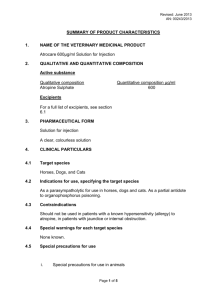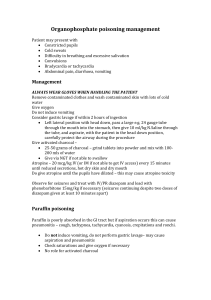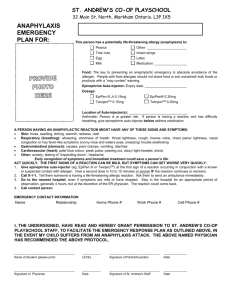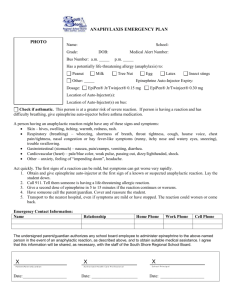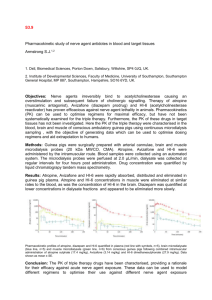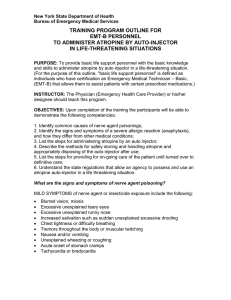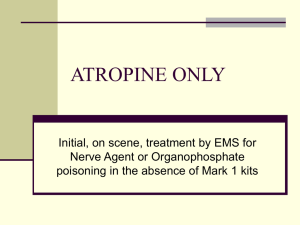Metro Omaha WMD Preparedness - Nebraska Regional Poison
advertisement
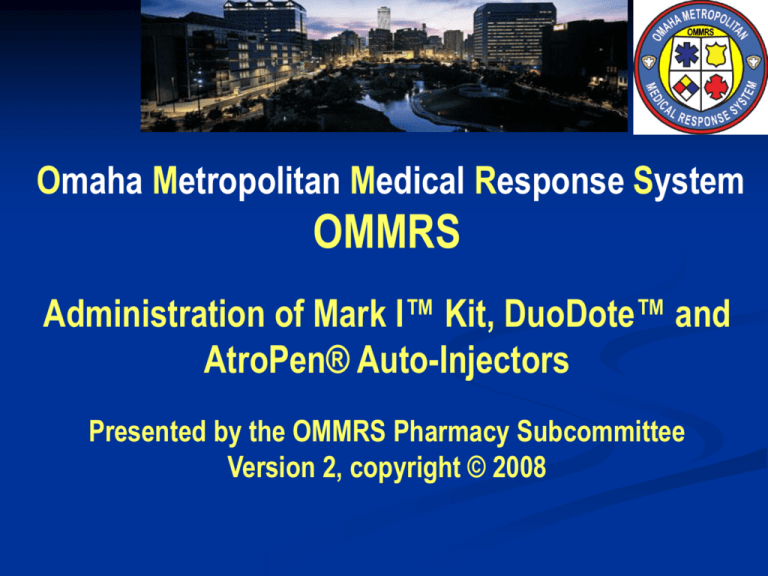
Omaha Metropolitan Medical Response System OMMRS Administration of Mark I™ Kit, DuoDote™ and AtroPen® Auto-Injectors Presented by the OMMRS Pharmacy Subcommittee Version 2, copyright © 2008 Treatment Disclaimer This video is intended to provide general guidelines and is not intended for individual patient care. Please contact a physician or your regional poison control center for patient-specific management advice as needed. Administration of Mark I™ Kit, DuoDote™ and AtroPen® Auto-Injectors Video Created by the Omaha Metropolitan Medical Response System Pharmacy Subcommittee Provides general information on the use and administration of the Mark I Kit, DuoDote, and AtroPen auto-injectors for nerve agent exposures Please check with your local fire department and MMRS for specific treatment protocols Nerve Agents Chemical Warfare Agents Tabun (GA) Sarin (GB) Soman (GD) VX Organophosphate Insecticides Malathion Parathion Lethal Amount of VX Mark I Kit Auto-Injector Contains: Atropine IM 2 mg in 0.7 milliliters Pralidoxime Chloride (2-PAM or Protopam) IM 600 mg in 2 milliliters Duodote Auto-Injector Contains: Atropine 2.1 mg in 0.7 milliliters and Pralidoxime Chloride (2-PAM or Protopam) 600 mg in 2 milliliters in two separate internal chambers. When activated, the DuoDote administers both drugs IM in a single autoinjector. The antidotes should only be used when signs and symptoms of exposure are present Self Protection Protect Yourself: Liquid contamination on clothing poses a vapor and dermal contact risk to care givers. Protection from vapors requires wearing air-supplied respirators such as self-contained breathing apparatus until the patient is decontaminated. Protect yourself by avoiding contact with skin or clothing of victims (wear chemical-protective clothing). Skin decontamination before patient enters squad or hospital Nerve Agents Treatment Aggressive Respiratory Support Suction Oxygen Intubation Assisted Ventilation S-M-I-L-E S Self-contained breathing apparatus M Mask and other PPE I Inject self or patient AND Initiate respiratory support L Leave area for decontamination E Evaluation by a medical team Nerve Agents Toxicity/Onset of Effects Nerve Agents and some organophosphate insecticides are extremely toxic by inhalation, ingestion, and dermal exposure Onset of clinical effects may be rapid following inhalation and ingestion or may be delayed up to 18 hours following dermal exposures Effects of Nerve Agents Mild Symptoms Pinpoint pupils (miosis) Excessive sweating Tearing (lacrimation) Drooling (salivation) Runny nose Mild chest tightness Mild shortness of breath Effects of Nerve Agents Moderate Symptoms Severe chest tightness Wheezing Profuse airway secretions Respiratory distress Vomiting, abdominal cramps Diarrhea Muscle weakness Effects of Nerve Agents Severe Symptoms Cyanosis Seizures Coma Flaccid paralysis Respiratory failure Apnea S-L-U-D-G-E-M S Salivation AND Sweating L Lacrimation (tearing of the eyes) U Urination D Defecation/Diarrhea G GI Upset (abdominal cramping) E Emesis AND Excessive Airway Secretions M Muscle Weakness/Paralysis AND Miosis Mark I Kit Injection Procedure 1. Remove Mark I Kit from the protective pouch. 2. With the non-dominant hand, hold the unit by the plastic clip so that the larger one is on top and both are positioned at eye level. 3. Remove the AtroPen from slot number one (1) of the plastic clip The yellow safety cap will remain in the clip and the AtroPen will now be armed. DO NOT hold unit by the green tip the needle injects from green tip. Mark I Kit Injection Procedure 4. With the other hand, check the injection site for buttons or objects in pockets which may interfere with the injections. 5. Grasp the unit and position the green tip of the AtroPen on victim’s outer thigh or buttocks. 6. Push firmly until the auto-injector fires. 7. Hold the injector firmly in place for at least 10 seconds. Mark I Kit Injection Procedure 8. Remove the Pralidoxime Chloride Pen from slot number two (2) of the plastic clip The grey safety cap will remain in the clip and the Pen will now be armed DO NOT hold the unit by the black tip – the needle injects from the black tip. 9. Grasp the unit and position the black tip of the Pen on victim’s alternate outer thigh or buttocks. Mark I Kit Injection Procedure 10. Push firmly until the auto-injector fires. 11. Hold the injector firmly in place for at least 10 seconds. 12. Place the auto-injectors in a sharps container. 13. Document the number of auto-injectors administered on the patient care report or the triage tag. 1 Kit DuoDote Injection Procedure 1. Remove the DuoDote from the plastic pouch. 2. Place the DuoDote in your dominant hand. Firmly grasp the center of the DuoDote with the green tip pointing down. Do not touch the green tip. 3. With your other hand, pull off the gray safety release. The DuoDote is now ready to be administered. DuoDote Injection Procedure 4. Make sure pockets at the injection site are empty. 5. Firmly push the green tip straight down against the outer thigh. Continue to firmly push until you feel the auto-injector trigger. 6. Hold the DuoDote in place for 10 seconds. 7. Remove the auto-injector from the thigh and look at the green tip. If the needle is visible, the drug has been administered. DuoDote Injection Procedure 8. If the needle is not visible, check to be sure the gray safety release has been removed and repeat the procedure. 9. Place the auto-injector in a sharps container. 10. Document the number of auto-injectors administered on the patient care report or triage tag. Auto-Injector Notes Auto-injector needle is 8/10 inch long Injector needle can go through clothing Injector needle may not penetrate bunker gear Give injections into a large muscle mass area such as the outer thigh or buttocks Treatment Guidelines Mild Symptoms Give One Mark I Kit OR One DuoDote 2 mg of Atropine & 600 mg of Pralidoxime Treatment Guidelines Moderate Give Symptoms Two MARK I Kits OR Two DuoDotes 4 mg of atropine & 1200 mg of pralidoxime Treatment Guidelines Severe Symptoms Give Three MARK I Kits OR Three DuoDotes 6 mg of atropine & 1800 mg of pralidoxime Diazepam (Valium) 5-10 mg Intramuscular or intravenous Administer to patients with seizures Consider for non-convulsing patients with severe symptoms Treatment Guidelines Continue to give additional 2 mg doses of Atropine at 5 to 10 minutes intervals as needed to dry excessive secretions Atropine Remember: Patients die a pulmonary death Atropine will dry lung secretions and relax bronchoconstriction Indicator of sufficient atropine dosing: decrease in lung secretions, decreased airway resistance, drying of nasal and oral secretions and improved respiratory function Pupil size should not be used as a guide for sufficient atropine dosing Atropine Insufficient atropine can result in fatalities Too much atropine can cause dilated pupils, dry mouth and skin, rapid heart rate, flushed skin, confusion, and urinary retention. Atropine overdose is rarely life-threatening Pralidoxime Adverse Effects Mild to moderate pain at injection site Other Side Effects: Blurred vision Headache Increased blood pressure Double vision Dizziness Drowsiness Tachycardia Hyperventilation Pediatric Use In a mass terrorist attack, proportionately more children than adults may be affected Pediatric patients may be more seriously ill than adults following the same exposure Best option is to dose atropine and pralidoxime based on the child’s weight Pediatric Dosing Atropine Pralidoxime Children: 0.05 mg/kg IV or IM every 5 to10 minutes as needed for bronchospasm and secretions Children: 25-50 mg/kg (max 1 gram/dose) IV or IM; repeat in one hour as needed Diazepam Children: 0.2-0.5 mg/kg IV or IM; may repeat every 5 to10 minutes as needed to control seizures Pediatric Use Atropine is most needed initially in the field and ideally should be given from pre-filled syringes, pediatric autoinjectors, or multi-dose vials The Mark I Kit auto-injector may be discharged into a sterile container, such as a vial, and the amount needed drawn up and given IM Do not give IV due to the preservative There is potential for injury from the injector needle when administered to small children In the absence of any other option, one Mark I Kit OR one DuoDote may be given to children weighing 12 kg or greater For the child in extremis, one Mark I Kit OR one DuoDote may be given, regardless of size Pediatric Use AtroPen is an atropine auto-injector available in various doses (0.25 mg, 0.5 mg, 1 mg, 2 mg) Use of a pediatric-strength AtroPen, facilitates the rapid administration of atropine doses to children AtroPen 0.5 mg contains atropine 0.5 mg/0.7 ml Dosing is based on child’s weight and severity of symptoms Pediatric Use Children weighing 13 to 40 pounds: Give One AtroPen 0.5mg auto-injector; repeat dose every 5-10 minutes as needed Children weighing 41 to 62 pounds: Give Two AtroPen 0.5mg auto-injectors; repeat entire dose every 5-10 minutes as needed Children weighing 63 to 84 pounds: Give Three AtroPen 0.5mg auto-injectors; repeat entire dose every 5-10 minutes as needed Children weighing greater than 84 pounds: Give One Mark I Kit OR one DuoDote; repeat dose every 5-10 minutes as needed AtroPen Injection Procedure 1. 2. 3. 4. Snap the grooved end of the plastic sleeve down and over the yellow safety cap. Remove the AtroPen from the plastic sleeve. Firmly grasp the AtroPen with the green tip pointed down. Pull off the yellow safety cap with your other hand. DO NOT touch the green tip - the needle injects from green tip. The auto-injector will go through clothing, but make sure that pockets near the injection site are empty. AtroPen Injection Procedure 5. 6. 7. 8. 9. Aim and firmly push the green tip against the outer thigh. Small children should also be injected in the thigh, but the thigh should be gently pinched to provide a thicker area for injection. Hold the auto-injector firmly in place for ten seconds. Remove the AtroPen and massage the injection site. Place the auto-injector in a sharps container. For additional information and guidance on the treatment of nerve agent and insecticide exposures, please contact your poison control center at 1-800-222-1222 Resources The Nebraska Regional Poison Center website www.nebraskapoison.com contains: OMMRS Administration of Mark I™ Kit, DuoDote™ and AtroPen® Auto-Injectors Video and Handout OMMRS Reference Cards NBC Agents Overview/Quick Reference Guide EMS Immediate Response NBC Reference Card Psychiatric Medication Resources in Emergencies References CDC Website: www.bt.cdc.gov Chemical Warfare Involving Kids Response Project Syllabus: CWIKresponse.com Domestic Preparedness Training Program Instructor Guide. U.S. Army Edgewood Research, Development and Engineering Center. 1998, BoozAllen and Hamilton Inc. and Science Applications International Corporation Henretig F, Mechem C, Jew R. “Potential use of autoinjector-packaged antidotes for treatment of pediatric nerve agent toxicity”, Ann of Emerg Med, 40:4, October 2002 MICROMEDEX® Healthcare Series Vol. 124, expires 12/2008



